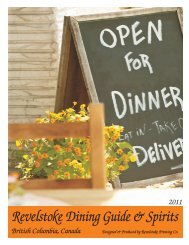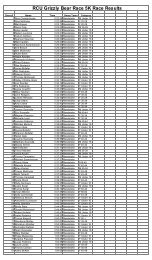Please click here to read Maltby's presentation - Revelstoke Current
Please click here to read Maltby's presentation - Revelstoke Current
Please click here to read Maltby's presentation - Revelstoke Current
Create successful ePaper yourself
Turn your PDF publications into a flip-book with our unique Google optimized e-Paper software.
A Citizen’s s approach <strong>to</strong><br />
Ecological Management of<br />
Invasive Plants:<br />
Your yard and Your community<br />
Francis L. Maltby - Presented at:<br />
Columbia Shuswap Invasive Species Society<br />
Meeting<br />
Revels<strong>to</strong>ke, B.C. June 20, 2013
Introduction<br />
What I am and what I am not.<br />
• not a biologist<br />
• not a botanist – you’ll find weeds!!<br />
• am a school bus driver = $<br />
• am an ecologist = ♥♥♥
Me at work
Me at play
Physical Ecologist<br />
• I am a “habitat” guy.<br />
• Interest in the physical condition which<br />
create and sustain habitats for various<br />
organisms; both plants and animals.<br />
• Interested in how organisms are affected<br />
by changes (good or bad) in the physical<br />
conditions of their habitats.
Habitat Assessments
General Principles of Ecological<br />
Management<br />
1 st prevent.<br />
• Use practices which promote and sustain natural<br />
barriers or controls <strong>to</strong> infestations.<br />
2 nd effective control and res<strong>to</strong>ration<br />
• Rapid response 1 and continued follow-up<br />
2<br />
• Use measures which support and sustain natural<br />
controls.<br />
• Do not use practices which favour invasives.<br />
1 can be very labour intensive<br />
2 usually much easier than initial response
Fac<strong>to</strong>rs which promote both<br />
common weeds and Invasives<br />
• Many invasives and common “weeds” follow linear corridors<br />
created by human disturbances. . Roads and pathways create<br />
habitats then our activities sp<strong>read</strong> the seeds.<br />
• Soil and site disturbances - <strong>to</strong>psoil loss, removal or erosion,<br />
removal of healthy native or domestic vegetation.<br />
• Poor nutrient and or moisture status.<br />
• Vegetation Management Practices - overgrazing, frequent<br />
mowing, scalping, inappropriate herbicide use.<br />
• Poor project planning - control, preparation and res<strong>to</strong>ration<br />
measures not considered in advance.<br />
• Failure <strong>to</strong> respond rapidly - control seed production and<br />
vegetative sp<strong>read</strong>.<br />
• Lack of public awareness and knowledge.<br />
• Climate change.
Many common<br />
weeds and invasives<br />
are “pioneer” species<br />
which thrive in areas<br />
disturbed by humans.<br />
Poor soil and or<br />
moisture<br />
conditions favour<br />
hardy “pioneer”<br />
species.
What I think I learned from a<br />
common “weed”.<br />
Oh, did I mention my bunny loves them<br />
and I can use them in salad?
May 2, 2013 May 2, 2013<br />
What’s going on <strong>here</strong>?<br />
May 9, 2013<br />
May 9, 2013
Possible responses <strong>to</strong> stress<br />
• Produce more flowers?<br />
• Attempt <strong>to</strong> complete reproductive cycle<br />
more quickly?<br />
• Produce multiple reproductive cycles?<br />
• If heavily grazed or mowed, change in<br />
growth form <strong>to</strong> compensate? I’ll I<br />
get<br />
smaller?
Under stress some<br />
plants respond by<br />
increasing<br />
reproductive effort.<br />
27 flower heads on a<br />
plant on a good site &<br />
under regular mowing.<br />
Average of 7 – 9 f.h.<br />
on my “happy” plants.
Working against natural defenses<br />
• Many common yard and grounds maintenance<br />
practices handicap natural defenses which can<br />
resist some invasive infestations.<br />
• Even modest changes in these practices can<br />
support these economic and effective natural<br />
defenses.<br />
• This simply means working with the vegetation<br />
we would prefer rather than creating ecological<br />
conditions which favour the vegetation we<br />
wish <strong>to</strong> prevent.
Heavy Grazing or Mowing?<br />
• Stresses desirable plant species, both<br />
grasses and broadleaf.<br />
• Reduces densities of desirable species<br />
opening “habitat” for weeds and invasives.<br />
• Favours certain weeds and invasives which<br />
are better adapted <strong>to</strong> heavy grazing or mowing.<br />
• Only increased water use, fertilizer and<br />
occasional herbicide applications can<br />
maintain desired grass / lawn species ability <strong>to</strong><br />
resist invasion by weeds and invasives.
Increased grazing<br />
and mowing reduce<br />
root growth.<br />
“When roots are<br />
longer, soil is better<br />
and plants are<br />
stronger.”<br />
- Carbon / nutrient s<strong>to</strong>rage<br />
+ Carbon / nutrient s<strong>to</strong>rage<br />
Canadian Agricultural<br />
Research Branch:<br />
Root growth of<br />
bunchgrass kept clipped<br />
at different heights.
A continuously grazed (or mowed) dryland pasture (or lawn)<br />
versus a well managed dryland pasture (or lawn)
Many species of weeds and invasives are well adapted <strong>to</strong><br />
heavy grazing (mowing) and poor soil conditions.<br />
These mowed dandelions only 3 cm. tall - lower than the mower - and<br />
still producing an abundant seed crop.
What seemed <strong>to</strong> work – Happy Plants?<br />
Less than 2% seed escapement for<br />
entire management area. Heavy<br />
initial work followed by small<br />
increments of follow-up work.<br />
I let these grow<br />
I picked these<br />
Letting the plant grow through the<br />
flower bud and flowering stages<br />
seemed <strong>to</strong> reduce the number of<br />
replacement flowers and slowed the<br />
re-flowering cycle.<br />
About 60 liters. <strong>to</strong>tal for<br />
entire management area
IGS Nature Park<br />
Map and Inven<strong>to</strong>ry Knapweed<br />
This inven<strong>to</strong>ry and ecological control project<br />
had four key objectives:<br />
1. Map and describe the distribution of Spotted<br />
Knapweed within and immediately adjacent the<br />
Illecillewaet Greenbelt Nature Park.<br />
2. Determine the mechanisms and patterns of<br />
distribution.<br />
3. Evaluate edaphic (soil) and biotic characteristics of<br />
Knapweed invasion sites.<br />
4. Determine role of native vegetation in moderating<br />
or controlling invasion rates or densities.
Most interesting findings<br />
• The native plant Dryas drummondii - Yellow<br />
Mountain Aven was resisting knapweed invasion.<br />
• Knapweed Density without Avens (5 plots)<br />
110, 42, 72, 15 & 41 / plants per sq. m. Average<br />
Density – 56 / sq. m. m<br />
• Knapweed Density with Avens (5 plots)<br />
11, 0 , 1, 0 & 0 / plants per sq. m. Average<br />
Density – 2.4 / sq. m.<br />
• In this region / climate, and without further<br />
disturbances, , native plants will eventually outcompete<br />
and replace knapweed on many sites.<br />
• Res<strong>to</strong>ration can be greatly accelerated using<br />
ecologically based methods.
Recommendations / Treatments<br />
• 1 st Do not import a “founding” seed source.<br />
• Try <strong>to</strong> prevent seed export.<br />
• Control seed production, pull plants if<br />
possible.<br />
• Try <strong>to</strong> avoid further disturbances in infested<br />
areas.<br />
• Introduce desired plants and or seeds<br />
ASAP.<br />
• Fertilize and irrigate if required (short term<br />
only during establishment stage).
Things I learned down by the marsh<br />
• Common control methods can be the worst<br />
possible treatments.<br />
• Fixing errors is very hard work.<br />
• Casual experimentation can produce<br />
interesting results.<br />
• Understanding your target species<br />
weaknesses is important.<br />
• Working with natural systems is a good<br />
strategy.
Methods and<br />
Treatments<br />
• Mow / mulch portion of area<br />
• Hand pull portion of area<br />
• Have a Control area<br />
• 9 - Peavine Plots<br />
• 5 - Native and agronomic<br />
grasses and forbs Plots<br />
• 2 - Grass clippings mulch<br />
Plots.<br />
• Nootka Rose mulch and<br />
fertilize.
Landscape cloth, wood mulch<br />
and fertilizer – Nootka Rose<br />
support and stimulus.<br />
Bare ground – vegetation plots<br />
Grass mulch – seed-bank kill plots
Most interesting findings<br />
• Knapweed density on this site increased due <strong>to</strong> herbicide application. It<br />
Killed the competition.<br />
• Pull or mulch plants when major energy has been committed <strong>to</strong> flower<br />
development but before viable seed are set and you have no disposal<br />
sal<br />
problems.<br />
• Plant density / sq. m. – counted plants<br />
• Bio-control affect – counted bugs.<br />
• Seed production / sq. m. counted seeds.<br />
10 cm. layer of fresh “green grass mulch” destroys<br />
the knapweed seed-bank<br />
on and in the soil!!<br />
• 10 cm. layer of fresh<br />
• Simply applying certain agronomic grasses and legume seeds <strong>to</strong> a site<br />
produced a reduced knapweed density within two years.<br />
• Fertilizer application greatly enhance the density and plant vigor of newly<br />
seeded grasses. Include N fixing plants on poor sites.
July 1, 2010 – 95% K.W.<br />
June 18, 2013 – < 20% K.W.
Citizen’s s Science<br />
• Citizen’s s science should be relaxed,<br />
educational and enjoyable.<br />
• In my EcoYard I try <strong>to</strong> be relaxed.
June 11, 2013<br />
June 23, 2010<br />
What’s up Buttercup?<br />
My mistake, failure <strong>to</strong> respond<br />
rapidly. = Much more work!
Good research can be found online<br />
Good queries: invasive Buttercup control<br />
Latin names: Ranunculus acris L. ecology<br />
I better check: Ranunculus acris L. <strong>to</strong>xicity
Google Earth Images<br />
Start with basic image<br />
• create a simple map, locations & density<br />
• develop management techniques<br />
• pho<strong>to</strong> document with measurement device<br />
• record starting conditions (plant densities)<br />
• document changes over time (annual)<br />
Map your yard or management area<br />
Management Units: record plant density /<br />
management practice
Measure, Record & Document<br />
Data: date, work time, location, method, species<br />
Plant Density<br />
Zero presence - 0 0 /sq. m.<br />
Very Low - VL < 2 / sq.m.<br />
Low – L 2-5 / sq.m.<br />
Med. – M 6-15 /sq.m.<br />
High – H 16-30/sq.m.<br />
Very High – VH > 30 /sq.m.
Treatments Applied - 2013<br />
1. Pulled and mowed plants <strong>to</strong> reduce seed<br />
production.<br />
2. Encourage vigorous competition from healthy<br />
grasses and forbs (in pulled areas).<br />
3. Mulch with grass clippings. Kill and reseed area.<br />
4. Cover with plastic. Kill and reseed.<br />
5. Cover with landscape cloth. Kill and reseed.<br />
6. Possible cultivate and reseed.
“Fun” science?<br />
“Citizen” Practitioner?<br />
“Spiritual” connection?<br />
All good. You decide!
EcoYards =<br />
Sanctuary & Core<br />
Values<br />
Community<br />
Diversity<br />
Thank you!





